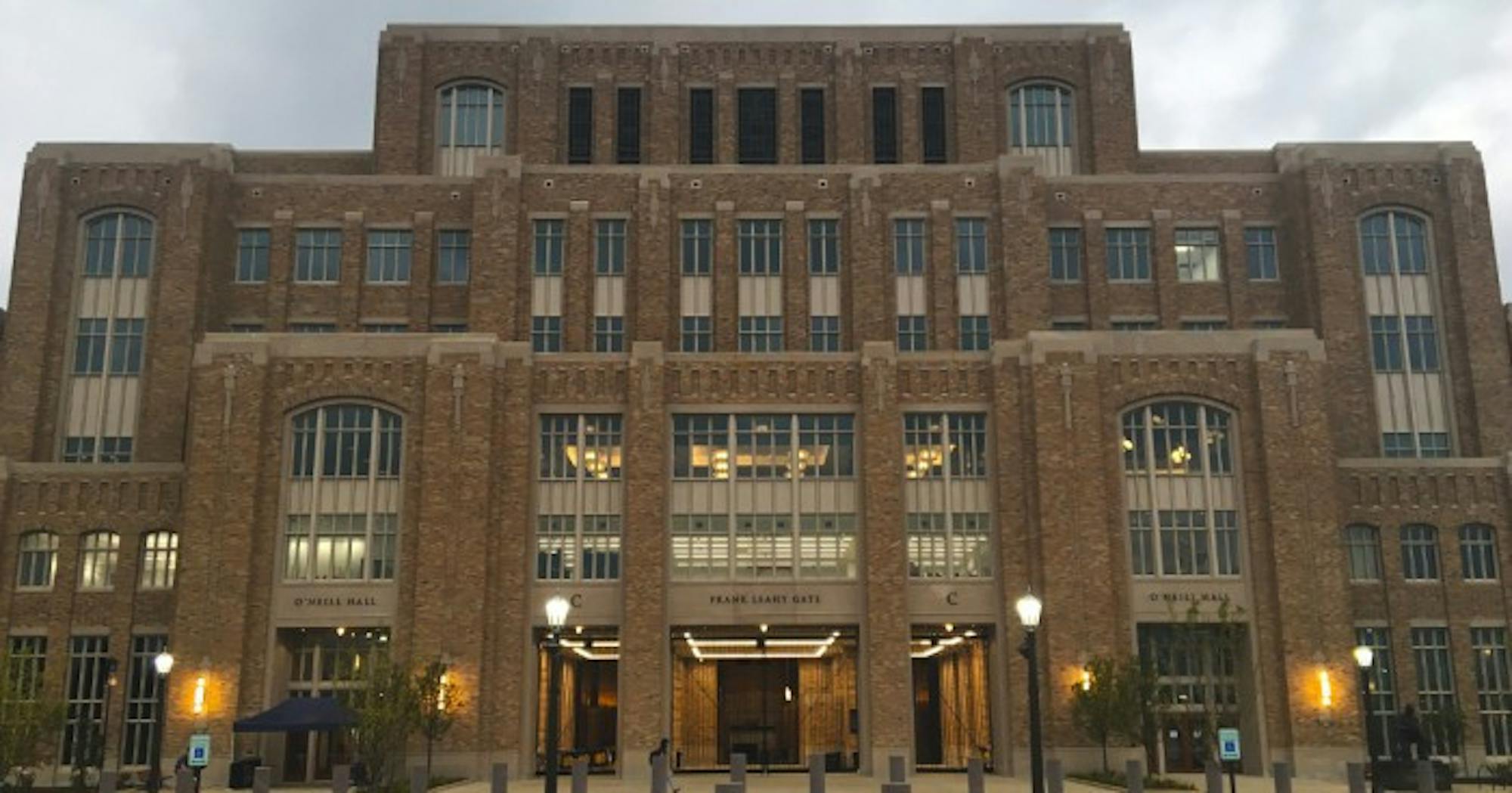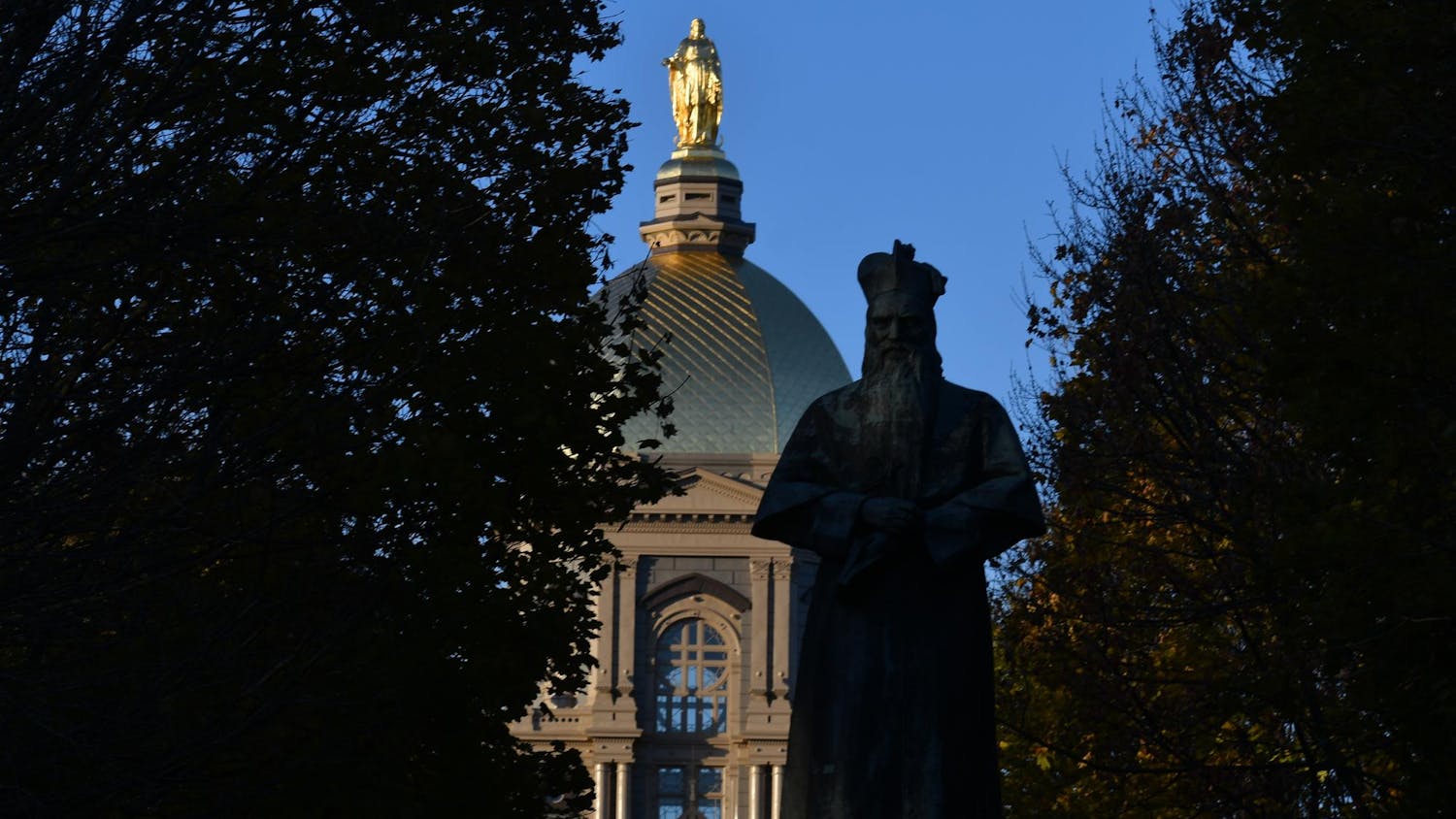Editor’s note: This is the third story in a three-part series featuring the completed Campus Crossroads project. Today’s story focuses on the enhancements to academics at Notre Dame resulting from the construction of O’Neill Hall and Corbett Family Hall.
The construction of O’Neill Hall and Corbett Family Hall marks a new era for the music, psychology and anthropology departments at Notre Dame.
Both part of the Campus Crossroads project, O’Neill Hall will be the new headquarters for music and sacred music, while Corbett Family Hall will house the psychology and anthropology departments.
John McGreevy, professor of history and dean of the College of Arts and Letters, said the completed project will be able to serve the Notre Dame community for generations to come.
“We really view this as a great day for the College of Arts and Letters, and for Notre Dame,” he said on a press tour conducted Aug. 11. “[These are] two spectacular new buildings that are going to advance research and teaching capacity of our students and faculty for a hundred years.”
The new facilities are an exciting step for the College of Arts and Letters, McGreevy said.
“I am a historian, so I’m neither a psychologist, anthropologist or musician, but these are my colleagues, as well, and to see them be able to have the opportunity to do the best possible work and to train their students in the best possible way — it’s magical,” McGreevy said.
O’Neill Hall
On the south end of Notre Dame Stadium stands O’Neill Hall, the first new building designed specifically for the music program since the 1800s.
“We didn’t build a music building in the 20th century,” McGreevy said. “There was one built in the late 19th century, and now we have one for the 21st century. And music and our program in sacred music will have the opportunity to flourish in a way they’ve never had before with recital halls, the practice rooms and simply the ability to put music front and center, as it should be at a Catholic university, in a Notre Dame student’s education.”
This new space was crucial for the music program, vice president for facilities design and operations Doug Marsh said on the press tour, because the department is currently squeezed into Crowley Hall, an undersized building for the program.
“Those programs are moving from quaint quarters in the heart of campus at Crowley Hall and about 9,000 square feet into over 30,000 square feet of usable space in that facility,” Marsh said. “They’re very excited, needless to say.”
Within O’Neill Hall is the LeBar Family Recital Hall, a 170-seat concert space, and the LeBar Family Performance Hall. Marsh said the smaller size of the LeBar Family Recital Hall is perfect for performances by smaller ensembles.
“It’s a size [of] space we haven’t been able to accommodate in other buildings on campus, so this works very well with the facilities at the DeBartolo Performing Arts Center, which of course are larger and such,” Marsh said. “This is perfect for our student voices and small quartets, etc.”
The program hopes to be able to utilize this component of the facility as soon as possible, Marsh said.
“We’re targeting to finish this, again, fall semester so that we have our faculty move in and we’ll have our first performances in here in January,” he said.
McGreevy said the impact of Campus Crossroads will be particularly noticeable for the music programs in light of the potentially enhanced performances.
“I think it’s going to be most vivid for the community here in O’Neill, where there will be recital halls open to the public and string quartets … and wonderful vocal performances and all sorts of things that will be open to members of the community,” McGreevy said. “I’ll add, too, that our sacred music program, I believe, has seven choirs of over 300 students from in the community. We just started a new sacred music choir for students with disabilities, and there’s a new collaboration with the South Bend school choir. All of those students will be coming into this building, too. So we really viewed this building, O’Neill, as a kind of portal to Notre Dame because our music programs really do reach out in the community.”
Corbett Family Hall
Corbett Family Hall, the building to the east of the stadium, will bring the psychology and anthropology departments together in a way they have never been before, McGreevy said.
“For the first time ever, those faculty and students will be together, and they’ll be able to move from the research lab — where our psychologists study things like depression and ADD — to the classrooms there to the faculty offices,” McGreevy said. “ … Our department of psychology at the moment has faculty and students in seven different buildings, and now they’ll almost all be consolidated in Corbett. And we don’t even know what that’ll mean for anthropology and psychology — that opportunity to collaborate — but we know it’ll be great for our students and faculty.”
While these departments do not necessarily do as much outreach work with the South Bend community as the sacred music program, McGreevy said their impact still goes beyond the University.
“Psychology and anthropology is a little bit more focused on Notre Dame, but even there, I would say — some of [the] psychologists see patients, some of them have clinical studies as part of what they do and even there there’ll be a community dimension to our work in psychology,” McGreevy said.
“The exciting part for me will be the day when the faculty and students move in. That will be the biggest day,” McGreevy said. “I, like everybody else in the community — and I live near campus — have been watching the buildings go up and involved in the planning and involved in figuring out which faculty member goes into which office. I’m not sure I’d call all of that exciting. It’s been fun, but the most exciting day will be when we see our students and faculty members come into these buildings. … These are hundred-year buildings. For the next hundred years they will be helping make Notre Dame and the college a better institution.”
The Martin Media Center
An extra element of Campus Crossroads that Marsh said he expects to contribute to the academic development of students and faculty is the Rex and Alice A. Martin Media Center on the first floor of Corbett Family Hall.
“This is a space for the University to better connect its message and put its message out to the world, but also for our faculty and our students to learn all things digital media,” Marsh said. “We’re learning in a different way, we’re teaching in a different way. So much of that information will be hosted and developed in that facility.”
Dan Skendzel, executive director of ND Studios, said the 2,000 square-foot facility has been in the works for a long time.
“This is really the next evolutionary step in media production that Fr. John Jenkins, our president, and John Affleck-Graves, our executive vice president, set out several years ago,” Skendzel said on the press tour.
The center offers students and faculty members the opportunity to be creative with their teaching and learning processes, Skendzel said.
“This space is really important for the University, largely because of the way communication has evolved and changed,” he said. “ … Characteristics like mobile, social and video are the way particularly younger generations are communicating. This center gives us the ability to compete in that space. So you think about academic, this space will be used for faculty to come in and record a lecture in the flipped classroom model so that students can go and view that lecture prior to class, and then come to class and use that for interaction time with other students and the faculty members.”
Skendzel said faculty members will also be able to take advantage of the facility.
“We’ll use this space for seminars on emerging technologies — so think virtual reality and bringing faculty in and showing them how virtual reality might be a factor in their research,” he said. “How can they use it for research? How can they use it in their [classrooms] for teaching and learning? We’ll use this space for all kinds of promotional and outreach uses.”
Aside from its academic benefits, Skendzel said the University will use the Martin Media Center to turn Notre Dame into a force in the producing sphere.
“This facility will set us up to be a leader in the ACC as the ACC Network moves towards a linear launch in 2019,” he said. “Dare I say, it sets us up to be the leader across the country and any school in terms of our capability to produce athletic press. But it also sets us up to be the leader in producing, period.”
Campus Crossroads to benefit academic life at Notre Dame
O’Neill Hall, built as part of the Campus Crossroads project, will serve as the new facility for both music and sacred music.
O’Neill Hall, built as part of the Campus Crossroads project, will serve as the new facility for both music and sacred music.









